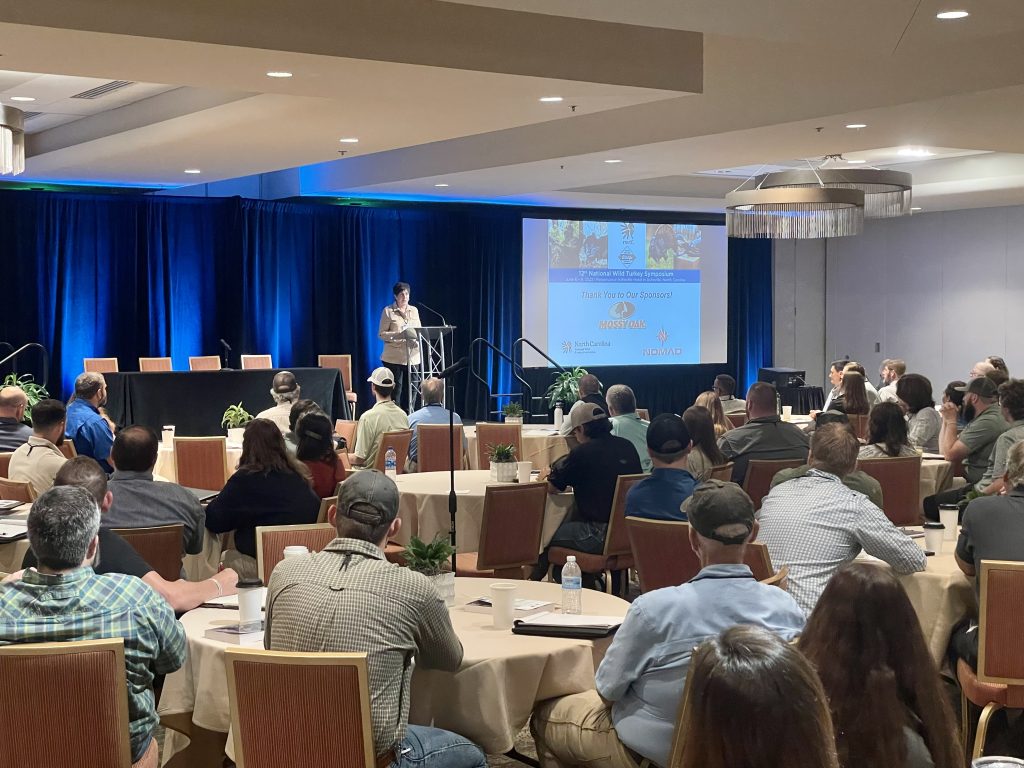12th National Wild Turkey Symposium Kicked Off with Call to Action, Novel Research and More
In a room full of academics, state and federal agency managers and all-around folks who revere the wild turkey, the 12th National Wild Turkey Symposium began by discussing the success of the bird’s restoration and how, since 1959, the Symposia have played an integral role in the restoration story which continues today.
NWTF Co-CEO Becky Humphries helped kick off the Symposium by discussing the importance of people from all arenas working in unison.
“We are all here because we care deeply about wild turkeys,” Humphries said. “While we at the NWTF invest heavily in wild turkeys, while we have tremendous volunteers all around the country who care deeply about our mission, we don’t have any management authority. We have tremendous researchers in this room, affiliated with great universities and top-shelf scientific expertise, but they, too, do not hold the management authority. But we have agency folks in here who do.”

Humphries illustrated the unison of conservationists, hunters, researchers and state agencies as the ultimate way to conserve wild turkeys. She further emphasized wild turkey research's importance by announcing the NWTF’s new $360,000 research investment.
New NWTF Co-CEO Kurt Dyroff also helped kick off the day, discussing the importance of the gathering.
“It is critical that we have the best and brightest turkey minds in this room at this very moment to address these issues, whether you represent a state or a federal agency, academia, industry, whether you’re a private landowner or you’re a part of the NWTF,” Dyroff said. “I suspect that years from now, we will look back at this very Symposium and identify these moments as a critical juncture for the future of the wild turkey. The challenges ahead are complex, and they’re not going to be solved with singular solutions, and no longer can we afford to be silent. Instead, we must create a broadscale collaboration between science, application, management and innovation.”
Throughout the first day of the gathering, academics and state managers presented and discussed novel research covering various topics. Presentations were broken into three overarching categories: human dimensions, disease ecology and habitat selection and movement ecology.
“Human dimensions refers to anything pertaining to the intersection of wild turkeys and human influence,” said Mark Hatfield, NWTF director of conservation services. “This can include anything from the varying methods wildlife managers use to acquire research data to how hunters hunt wild turkeys in the spring.”
Presentations in the human dimensions category included:
• “Status and Distribution of Wild Turkeys in the United States,” presented by Mike Chamberlain of the University of Georgia;
• “A Demographic Understanding of Hunting Mentors and Mentees in Florida,” presented by Nicholas Baker of the University of Georgia;
• “Response Rate and Content Difference between Web and Mail Surveys,” presented by Roger Shields of Tennessee Fish and Wildlife Commission;
• “Connecting Behaviors and Experiences of Spring Turkey Hunters to Their Satisfaction and Success,” presented by Adam Butler of the Mississippi Department of Wildlife, Fisheries and Parks; and
• “Effects of the COVID-19 Pandemic on 2020 Spring Turkey Hunting Across the United States,” presented by Zak Danks of the Kentucky Department of Fish and Wildlife Resources.
Disease ecology was the second category in which researchers presented. Research in this category included:
• “Active and Passive Disease Surveillance in Wild Turkeys from Pennsylvania, USA,” presented by Justin Brown of Pennsylvania State University;
• “Our Current Understanding of West Nile Virus in Upland Game Birds,” presented by Melanie Kunkel of the University of Georgia;
• “Prevalence of Lymphoproliferative Disease in North Carolina,” presented by Chris Kreh of the North Carolina Wildlife Resources Commission; and
• “Impact of Hurricanes on Wild Turkey Survival, Movement, and Home Range,” presented by David Moscicki of NC State University.
The final segment of the first day of the 12th Symposium entailed habitat selection and movement ecology. Presentations in this segment included:
• “Habitat Selection of Translocated Eastern Wild Turkeys in East Texas” and “Space-Use, Movements, and Survival of Translocated Eastern Wild Turkeys in East Texas,” both presented by Chamberlain;
• “Movement and Spatial Ecology of Translocated Merriam’s and Gould’s Wild Turkeys,” illustrated by Brett Collier of Louisiana State University; and
• “Foraging and Travel Success of Wild Turkey Poults in Fire-Managed Versus Unmanaged Grasslands in Southern Illinois,” presented by Ryan Tebo of the Minnesota Department of Natural Resources.
In short, the first day of the 12th National Wild Turkey Symposium revealed there is much still to learn about this iconic game bird. It will take a cross-boundary approach from all arenas with more laser-focused research to solve many questions surrounding populations, disease, human influence and habitat.

Stay tuned for day-two coverage and look out for NWTF’s Turkey Call All Access Podcast, where host Fred Bird sits down with researchers, personalities and NWTF biologists to distill this information and what it means for turkey hunters.
